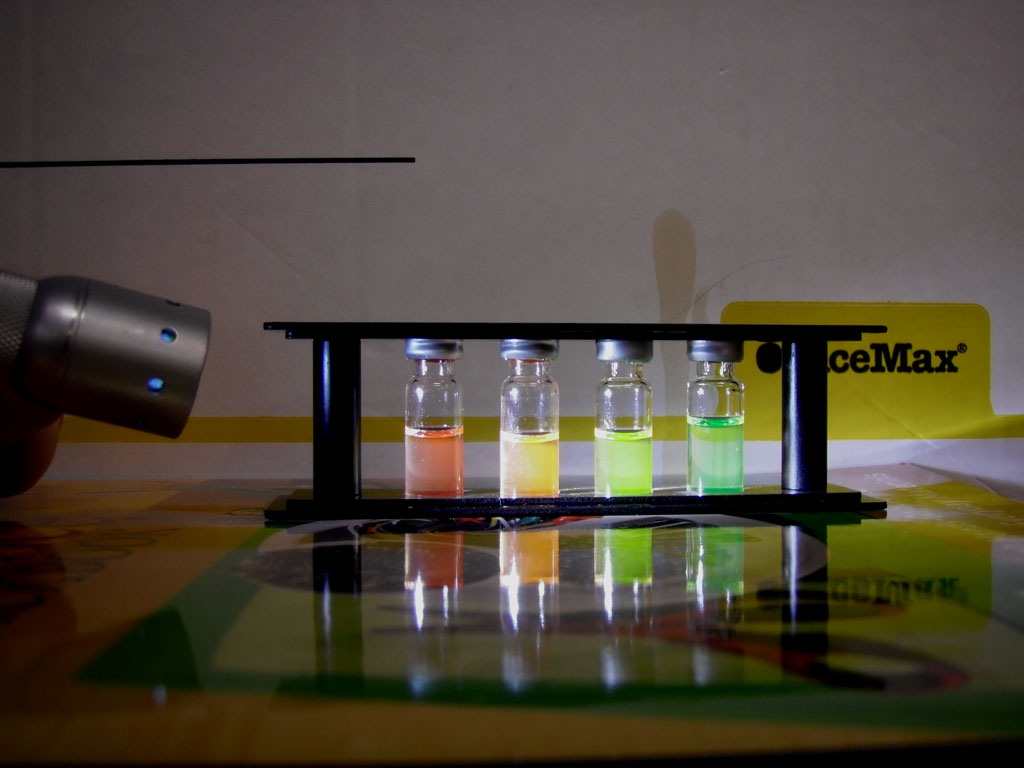Size Matters

The size of a quantum dot changes its energy levels.
Size Matters

The size of a quantum dot changes its energy levels.
Introduction
Electrons in a nanoscale particle change their energy levels when the size of the particle changes.
The change in energy levels changes the energy and therefore the color of the fluorescent light emitted by the particles.
Material
Quantum Dots Cenco 1751-18 (Cost in 2010 $110)
A bright white or blue/violet lightsource. Minimag light, or white LED. (optional red green and blue LED lights.)
A coiled phonecord, 25 foot length.
Assembly
To Do and Notice
Shine the white light into the tubes with different size quantum dots.
Observe the color of the emitted light.
Notice how the color depends on the size of the dots.
What’s Going On?
The quantum dots are made of spheres of indium phosphide which is a semiconductor, coated in a thin layer of zinc sulfide and suspended in tetradecane solution. The orange light emitting quantum dot is about 3 nm in diameter.
An incident photon can create an electron hole pair each in its own ground state. In the spherical "box" of the semiconductor. At this scale and in this box the electron is a wave.
The wavelength, L, of a particle in a box in its ground state, n =1, is longer for a wider box. The wavelength of an electron is related to its momentum, p, by L = h/p where h is planck's constant. So when you see an electron wavelentgh you know it is inversely proportional to the momentum. and so the kinetic energy, KE, (which is proportional to the momentum squared K = p^2/m) in inversely proportional to the square of the wavelength. By looking at these wavelengths you can see the relative kinetic energies of the electrons in these boxes.
When the electron and hole recombine a photon is emitted. Smaller dots emit higher energy photons.
The energy of the photon is proportional to the energy of the band gap of indium phosphide plus the kinetic energy of the electron plus the kinetic energy of the hole. As the radius of a spherical quantum dot increases the kinetic energy of the electron in the ground state decreases proportional to the square of the radius. So the energy of the emitted photon decreases as the dots increase in size. Thus large quantum dots emit red light, and small ones green light.
You can model this with a coiled phone cord.
Stretch the phone cord between two people to a length of 5m (15 feet).
Oscillate it up and down to create 1/2 of a wave on the phone cord. This is the ground state oscillation. Note the frequency, f . Perhaps the frequency is 1 Hz.

Notice the kinetic energy in the oscillation. Put your hand into the middle of the moving wave and allow it to slap your hand to feel the kinetic energy.
To model a smaller quantum box have someone grab the cord at 2.5 m, half the length of the original cord. (The half-cord will be half of the original cord mass and length with the same tension.)
Oscillate this short cord to create 1/2 a wave, the ground state. Notice that the frequency is double the original frequency. f = 2Hz.
Place your hand in the middle to stop the oscillating cord and notice that the kinetic energy is higher.
For the electron in the quantum box the kinetic energy is proportional to the inverse square of the radius of the spherical box.
Etc
Donald Schnitzler has done a study of these quantum dots. His findings are summarized here:
http://www.compadre.org/advlabs/tcal/Detail.cfm?id=2677
|
Scientific Explorations with Paul Doherty |
|
17 November 2010 |